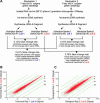A new resource for cereal genomics: 22K barley GeneChip comes of age
- PMID: 15020760
- PMCID: PMC389919
- DOI: 10.1104/pp.103.034462
A new resource for cereal genomics: 22K barley GeneChip comes of age
Abstract
In recent years, access to complete genomic sequences, coupled with rapidly accumulating data related to RNA and protein expression patterns, has made it possible to determine comprehensively how genes contribute to complex phenotypes. However, for major crop plants, publicly available, standard platforms for parallel expression analysis have been limited. We report the conception and design of the new publicly available, 22K Barley1 GeneChip probe array, a model for plants without a fully sequenced genome. Array content was derived from worldwide contribution of 350,000 high-quality ESTs from 84 cDNA libraries, in addition to 1,145 barley (Hordeum vulgare) gene sequences from the National Center for Biotechnology Information nonredundant database. Conserved sequences expressed in seedlings of wheat (Triticum aestivum), oat (Avena strigosa), rice (Oryza sativa), sorghum (Sorghum bicolor), and maize (Zea mays) were identified that will be valuable in the design of arrays across grasses. To enhance the usability of the data, BarleyBase, a MIAME-compliant, MySQL relational database, serves as a public repository for raw and normalized expression data from the Barley1 GeneChip probe array. Interconnecting links with PlantGDB and Gramene allow BarleyBase users to perform gene predictions using the 21,439 non-redundant Barley1 exemplar sequences or cross-species comparison at the genome level, respectively. We expect that this first generation array will accelerate hypothesis generation and gene discovery in disease defense pathways, responses to abiotic stresses, development, and evolutionary diversity in monocot plants.
Figures

References
-
- Arumuganathan K, Earle ED (1991) Nuclear DNA content of some important plant species. Plant Mol Biol Rep 9: 208-218
-
- Choi DW, Zhu B, Close TJ (1999) The barley (Hordeum vulgare L.) dehydrin multigene family: sequences, allelic variation, chromosome assignments, and expression characteristics of 11 Dhn genes of cv. Dicktoo. Theor Appl Genet 98: 1234-1247
-
- Choi DW, Koag MC, Close TJ (2000) Map locations of barley Dhn genes determined by gene-specific PCR. Theor Appl Genet 101: 350-354
-
- Ewing B, Green P (1998) Base-calling of automated sequencer traces using Phred: II: Error probabilities. Genome Res 8: 186-194 - PubMed
Publication types
MeSH terms
Substances
LinkOut - more resources
Full Text Sources
Other Literature Sources
Molecular Biology Databases

